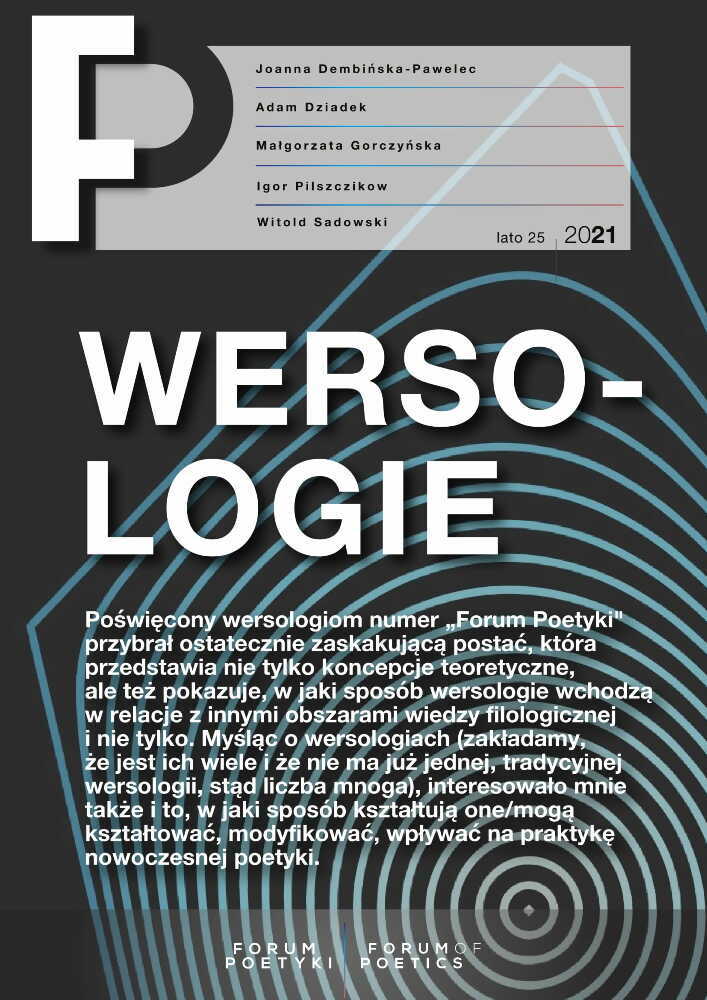Abstract
The free verse is taken here to be a graphic text, i.e. a technique operating the layout of signs on a page. The problem of translating thus understood versification into foreign languages is considered here on the basis of Reverdy’s and Pound’s poems. This article puts forward a hypothesis, that misunderstandings resulting from differences between the original structure and the one appearing in the translation are caused by culturally embedded beliefs about the melodic nature of a free verse. At the same time, considerations of the specific role of the translator of a graphic text lead to conclusions as to why that translator sometimes decides to verbalise the semantics of versification and translate the words of the original by means of the graphic layout.
References
Andrews, Richard. A Prosody of Free Verse: Explorations in Rhythm. New York: Routledge, 2017.
Balcerzan, Edward. Przez znaki. Granice autonomii sztuki poetyckiej. Na materiale polskiej poezji współczesnej. Poznań: Wydawnictwo Poznańskie, 1972.
Beltrami, Pietro G. La metrica italiana. Bologna: Il Mulino, 2011.
Beyers, Chris. A History of Free Verse. Fayetteville: The University of Arkansas Press, 2001.
Chol, Isabelle. Pierre Reverdy. Poésie plastique. Formes composées et dialogue des arts (1913-1960). Genève: Droz, 2006.
Claudel, Paul. Œuvres en prose. Wydane przez Jacques Petit, Charles Galpérine. Paris: Gallimard, 1965.
Collot, Michel. „L’horizon typographique dans les poèmes de Reverdy”, Littérature 46 (1982): 41–58.
Coppo, Elena. „Pour l’oreille o pour l’oeil. Il verso libero di Laforgue e Claudel”. W Oralità e scrittura: i due volti delle parole, zredagowane przez Teresa Cancro, Chiara De Paoli, Francesco Roncen, Valeria Russo. Padova: Padova University Press, 2019, 143–53.
Dembińska-Pawelec, Joanna. „Poezja jest sztuką rytmu”. O świadomości rytmu w poezji polskiej dwudziestego wieku (Miłosz – Rymkiewicz – Barańczak). Katowice: Wydawnictwo Uniwersytetu Śląskiego, 2010.
Dłuska, Maria. Studia z historii i teorii wersyfikacji polskiej. Warszawa: Państwowe Wydawnictwo Naukowe, 1978, tom 1.
Dujardin, Édouard. Les premiers poètes du vers libre. Paris: Mercure de France, 1922.
Dziadek, Adam. Projekt krytyki somatycznej. Warszawa: Instytut Badań Literackich PAN, 2014.
Eliot, T.S. Szkice krytyczne. Przetłumaczone przez Maria Niemojowska. Warszawa: Państwowy Instytut Wydawniczy, 1972.
Grabowski, Artur. „Czemuż to wiersze pisze się wierszem?”, Pamiętnik Literacki 86 (1995), nr 3: 69–81.
Hartman, Charles O. Free Verse: An Essay on Prosody. Princeton: Princeton University Press, 1980.
Hermans, Theo. The Structure of Modernist Poetry. London: Croom Helm, 1982.
Leśmian, Bolesław. Szkice literackie. Warszawa: Państwowy Instytut Wydawniczy, 1959.
Lorenz, Otto. Poesie fürs Auge. W Hans-Jost Frey, Otto Lorenz, Kritik des freien Verses, 83–124. Heidelberg: Lambert Schneider, 1980.
Mleczko, Stanisław. Serce a heksametr, czyli gieneza metryki poetyckiej w związku z estetycznym kształceniem się języków, szczególnie polskiego. Warszawa: Wende, 1901.
Navarro Tomás, Tomás. Métrica española, Reseña histórica y descriptiva. Madrid: Guadarrama, 1956.
Pinsky, Robert. The Sounds of Poetry. A Brief Guide. New York: Farrar, Straus and Giroux, 1998.
Pound, Ezra. The Cantos. London: Faber & Faber: 1975.
Pound, Ezra. The Cantos. New York: New Directions, 1998.
Pound, Ezra. A Draft of XVI Cantos. Paris: Three Mountains, 1925.
Pound, Ezra. Pieśni. Wybrane przez Andrzej Sosnowski. Warszawa: Państwowy Instytut Wydawniczy, 1996.
Pound, Ezra. The Pisan Cantos. London: Faber & Faber, 1949.
Pound, Ezra. Poezje. Przetłumaczone przez Jerzy Niemojowski. Warszawa: Wojciech Pogonowski, 1993.
Przyboś, Julian. Linia i gwar. Szkice. Tom 2. Kraków: Wydawnictwo Literackie, 1959.
Pszczołowska, Lucylla. Rym. Wrocław: Zakład Narodowy im. Ossolińskich, 1972.
Reverdy, Pierre. Main d’œuvre: poèmes 1913–1949. Paris: Mercure de France, 1949.
Reverdy, Pierre. Œuvres complètes. Zredagowane przez Étienne-Alain Hubert. Tom 1–2. Paris: Flammarion, 2010.
Reverdy, Pierre. Plupart du temps. Tom 1. Paris: Gallimard, 1969.
Reverdy, Pierre. Poezje wybrane. Przetłumaczone przez Julia Hartwig. Warszawa: Państwowy Instytut Wydawniczy, 1986.
Sadowski, Witold. „«Potyczka we wsi Wiersze», czyli wersyfikacja jako temat poezji najnowszej”. W Nowy autotematyzm? Metarefleksja we współczesnej humanistyce, zredagowane przez Agnieszka Waligóra, 45–59. Poznań: Wydawnictwo Naukowe UAM, 2021.
Sadowski, Witold. „Psychofizjologia rytmu Stanisława Mleczki”. Opublikowane 14 marca 2012. Sensualność w kulturze polskiej. Dostęp 24 czerwca 2021, http://sensualnosc.bn.org.pl.
Sadowski, Witold. Tekst graficzny Białoszewskiego. Warszawa: Wydział Polonistyki UW, 1999.
Sadowski, Witold. Wiersz wolny jako tekst graficzny. Kraków: Universitas, 2004.
Skibski, Krzysztof. Poezja jako iteratura. Relacje między elementami języka poetyckiego w wierszu wolnym. Poznań: Wydawnictwo Naukowe UAM, 2017.
Utrera Torremocha, Victoria. “Tipografía y verso libre”. Rhythmica 2, nr 2 (2004): 251–73.
Wyka, Kazimierz. „Wola wymiernego kształtu”. W Rzecz wyobraźni, 223–240. Warszawa: Państwowy Instytut Wydawniczy, 1977.
Гаспаров, Михаил Леонович. Очерк истории европейского стиха. Москва: Фортуна, 2003
License
Authors of articles are responsible for securing the rights to other publications (texts, tables, drawings and other illustrations) quoted or reproduced in their texts.

